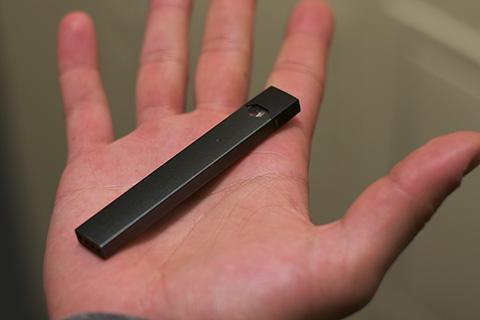A new form of e-cigarette called “JUUL” has been raising eyebrows thanks to its popularity, especially with high school and college students. In a matter of just two years, the product has gained one of the largest market shares in the e-cigarette business, putting younger generations at risk for health problems ranging from early nicotine addiction to diabetes.
With a new class of Werner H. Kirsten and summer interns at NCI at Frederick, it is crucial to understand these risks. Here is what you need to know.
What Is JUUL?
The JUUL resembles the more common vape pen and comprises similar components, such as a battery and a heating element, but it is smaller and sleek enough to fit in a tightly closed fist. It is easily portable and closely resembles a flash drive.
To operate the device, users insert a cartridge that contains a flavored oil, which gets heated. Once inhaled, the oil creates a vapor that dissipates into the air, much like a vape pen or an e-cigarette.
Not only has the JUUL’s sophisticated manufacture caught the attention of younger generations, but its oils also come in a variety of flavors, including mango, mint, and crème brûlée. Unknown to many, it also contains nicotine, an addictive and toxic chemical more commonly associated with tobacco. A single cartridge of oil is considered to be equal to a pack of cigarettes, or roughly 200 cigarette puffs.
What Are the Risks?
Adolescents who use the JUUL are at greater risk for long-term health issues because of the many dangerous complications caused by nicotine. As both a sedative and a stimulant, nicotine creates a single surge of adrenaline throughout the body, increasing both heart rate and blood pressure.
According to the U.S. Centers for Disease Control and Prevention, nicotine not only creates imbalances in the heart but also causes the pancreas to reduce its insulin output, making smokers 30–40 percent more likely to develop type 2 diabetes than nonsmoking individuals. Nicotine has also been linked to inhibited brain development in teens. The younger the user, the more dangerous the effects can be on their development.
New JUUL packaging is currently required to state, “This product contains chemicals known to the State of California to cause cancer and birth defects or other reproductive harm,” according to the California Proposition 65 warning, which is placed on all objects containing hazardous materials. However, while there have been a few rumors of students being diagnosed with cancer from JUULing, the JUUL is not linked to any reported diagnoses or deaths from cancer, specifically lung cancer, in the United States.
How Can I Help?
The best way to discourage adolescents and students from using the JUUL is to provide them with detailed information about how dangerous these products can be. There are many programs that help inform students about the harmful effects of nicotine and tobacco use. For example, the U.S. Food and Drug Administration incorporates a STEM (science, technology, engineering, and math)–based approach that addresses the public health issues of tobacco products. Once students are informed about the JUUL’s hazardous effects on the body, they may reconsider using such products.
Occupational Health Services (OHS) at NCI at Frederick is another educational source to contact. If you are a mentor and notice that one of your interns is struggling with addiction, a good starting point is to refer them to the OHS staff for counseling and discussions where they can ask questions and raise concerns. There is also the employee assistance program, which helps employees with personal and work-related struggles for free.


